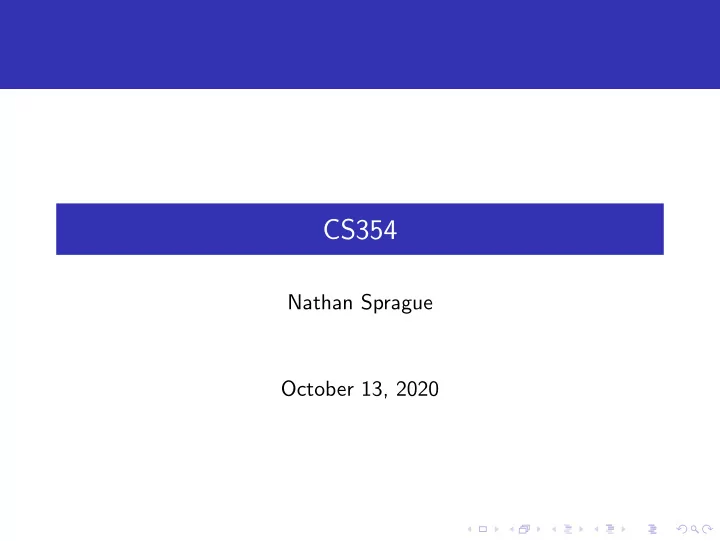

CS354 Nathan Sprague October 13, 2020
Probabilistic State Representations: Continuous Probabilistic Robotics. Thrun, Burgard, Fox, 2005
Probability Density Functions Represent probability distributions over random variables: Properties: f ( x ) ≥ 0 � ∞ f ( x ) dx = 1 −∞ Interpretation: � b P ( a ≤ x ≤ b ) = f ( x ) dx a
Expectation, Variance Expectation (continuous) (also referred to as the ”mean” or ”first moment”) � µ = E [ x ] = xf ( x ) dx Expectation (discrete) n � E [ X ] = P ( x i ) x i 1 Variance (also referred to as the ”second moment”) σ 2 = E [( x − E [ x ]) 2 ]
Quiz 1 What is the expectation of this pdf?
Quiz 2 n � E [ X ] = P ( x i ) x i 1 σ 2 = E [( x − E [ x ]) 2 ] Imagine we are rolling a four-sided die. The following probability distribution describes the probability for each number that we could roll: P(X = 1) = .7 P(X = 2) = .1 P(X = 3) = .1 P(X = 4) = .1 What is the expected value of this distribution? What is the variance?
Sample Mean and Variance Expectation and variance are properties of distributions. We can also calculate the sample mean and the sample variance for a given data set: { x 1 , x 2 , ..., x n } . Sample mean n m = 1 � x i n i =1 Sample variance n s 2 = 1 � ( x i − m ) 2 n i =1
Normal Distribution 1 e − ( x − µ )2 f ( x , µ, σ ) = √ 2 σ 2 2 π σ ( Normal because of the central limit theorem.) All distributions
Vector-Valued State We’ll need to generalize all of this to the case where the state of the system can’t be represented as a single number. Use a vector x to represent the state.
Covariance cov ( x , y ) = E [( x − µ x )( y − µ y )] Properties: cov ( x , y ) = cov ( y , x ) If x and y are independent, cov ( x , y ) = 0 If cov ( x , y ) > 0, y tends to increase when x increases. If cov ( x , y ) < 0, y tends to decrease when x increases.
Covariance Matrix Covariance matrix: x ) T ] cov ( x ) = Σ x = E [( x − ˆ x )( x − ˆ Where x is a random vector and ˆ x is the vector mean. The entry at row i, column j in the matrix is cov( x i , x j ) Multivariate normal distribution is parameterized by the mean vector and covariance matrix.
Multivariate PDF Example � 3 � � 1 0 � x = , Σ = 3 0 1
Multivariate PDF Example � 3 � � 1 0 � x = , Σ = 3 0 1
Multivariate PDF Example � 3 � � . 2 0 � x = , Σ = 3 0 1
Multivariate PDF Example � 3 � � . 2 0 � x = , Σ = 3 0 1
Multivariate PDF Example � 3 � � 1 . 9 � x = , Σ = 3 . 9 1
Multivariate PDF Example � 3 � � 1 . 9 � x = , Σ = 3 . 9 1
Multivariate PDF Example � . 5 � 3 � − . 3 � x = , Σ = 3 − . 3 2
Multivariate PDF Example � . 5 � 3 � − . 3 � x = , Σ = 3 − . 3 2
Why is this Useful For Localization? Memory and computation requirements grow exponentially for grid-based disributions. E.g. if we want 100 cells per dimension, we need 100 d cells. To approximate with a normal distribution we need d 2 + d to store.
Can We Do Recursive State Estimation? Two Steps: Prediction based on system dynamics: � Bel − ( x t ) = p ( x t | x t − 1 ) Bel ( x t − 1 ) dx t − 1 Correction based on sensor reading: Bel ( x t ) = η p ( z t | x t ) Bel − ( x t ) YES. The Kalman filter. Next time.
Recommend
More recommend